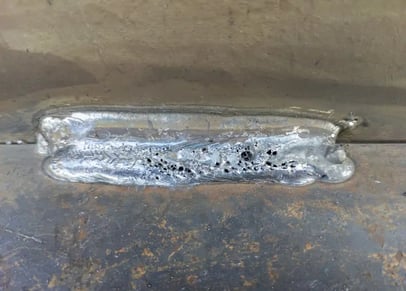Comprehending Porosity in Welding: Exploring Causes, Effects, and Avoidance Methods
Porosity in welding is a consistent difficulty that can substantially influence the top quality and stability of welds. As professionals in the welding industry are well mindful, comprehending the causes, results, and prevention techniques associated with porosity is vital for attaining robust and dependable welds. By diving into the origin of porosity, analyzing its destructive results on weld quality, and checking out effective avoidance techniques, welders can boost their knowledge and skills to produce premium welds constantly. The elaborate interaction of elements contributing to porosity calls for a comprehensive understanding and a proactive approach to make certain successful welding end results.
Usual Root Causes Of Porosity
Contamination, in the form of dirt, oil, or rust on the welding surface, produces gas pockets when warmed, leading to porosity in the weld. Inappropriate securing happens when the securing gas, generally used in processes like MIG and TIG welding, is unable to fully protect the molten weld pool from responding with the bordering air, resulting in gas entrapment and subsequent porosity. Additionally, inadequate gas coverage, often due to incorrect flow prices or nozzle positioning, can leave parts of the weld vulnerable, allowing porosity to develop.
Results on Weld High Quality
The presence of porosity in a weld can substantially compromise the general high quality and honesty of the welded joint. Porosity within a weld creates voids or tooth cavities that damage the framework, making it a lot more at risk to fracturing, corrosion, and mechanical failing.
Additionally, porosity can hinder the performance of non-destructive testing (NDT) methods, making it challenging to identify other issues or stoppages within the weld. This can cause considerable safety and security problems, particularly in crucial applications where the architectural integrity of the bonded components is critical.

Prevention Techniques Review
Given the detrimental impact of porosity on weld quality, efficient prevention techniques are vital to keeping the structural honesty of welded joints. One of the key prevention strategies is thorough cleansing of the base materials prior to welding. Contaminants such as oil, oil, corrosion, and dampness can contribute to porosity, so guaranteeing a clean job surface area is necessary. Proper storage of welding consumables in completely dry conditions is likewise important to avoid dampness absorption, which can cause gas entrapment during welding. Furthermore, picking the appropriate welding parameters, such as voltage, current, and take a trip rate, article can aid minimize the danger of porosity formation. Making sure appropriate protecting gas flow and coverage is another crucial avoidance technique, as not enough gas protection can lead to atmospheric contamination and porosity. Correct welder training and accreditation are crucial for implementing preventative steps efficiently and constantly. By incorporating these avoidance strategies right into welding techniques, the incident of porosity can be considerably reduced, causing stronger and extra reliable bonded joints.
Importance of Proper Shielding
Correct protecting in welding plays a crucial function in stopping climatic contamination and making certain the integrity of bonded joints. Securing gases, such as argon, helium, or a mix of both, are generally utilized to secure the weld pool from reacting with components in the air like oxygen and nitrogen. When these reactive components enter contact with the warm weld pool, they can cause porosity, leading to weak welds with minimized mechanical residential or commercial properties.

Inadequate shielding can lead to different problems like porosity, spatter, and oxidation, endangering the architectural integrity of the bonded joint. Consequently, sticking to appropriate shielding practices is important to produce top notch welds with minimal flaws and make sure the longevity and integrity of the welded parts (What is Porosity).
Surveillance and Control Approaches
Exactly how can welders effectively monitor and control the welding procedure to ensure optimal results and stop defects like porosity? By continually monitoring these variables, welders can determine inconsistencies from the suitable conditions and make prompt modifications to stop porosity development.

In addition, applying proper training programs for welders is vital for monitoring and managing the welding process properly. What is Porosity. Educating welders on the significance of preserving constant specifications, such as correct gas protecting and travel speed, can aid stop porosity problems. Regular assessments and certifications can additionally ensure that welders are competent in surveillance and controlling welding procedures
Moreover, the usage of automated welding systems can improve tracking and control capacities. These systems can specifically control welding parameters, minimizing the likelihood of human error and making sure consistent weld high quality. By incorporating innovative tracking innovations, training programs, and automated systems, welders can successfully Extra resources keep track of and regulate the welding procedure to minimize porosity flaws and accomplish top quality welds.
Conclusion

Comments on “What is Porosity in Welding: Common Resources and Efficient Remedies”